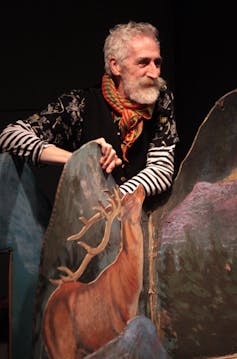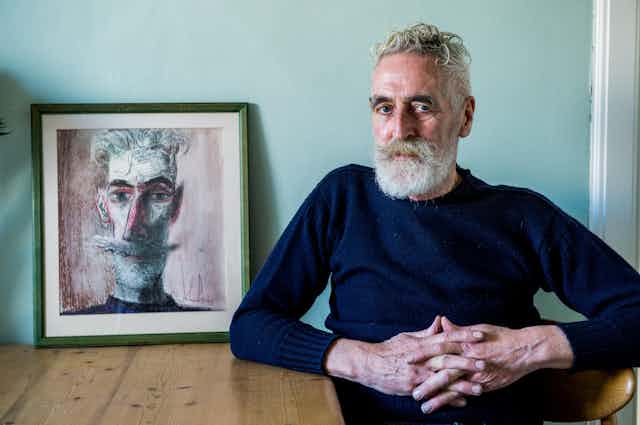Marking his immense contribution to the creative life of Scotland, a great outpouring of affection for the artist and playwright John Byrne followed the announcement that he had died at the age of 83 – fittingly perhaps – on St Andrew’s Day.
His impressive catalogue of outstanding works developed over the last 60 years has become synonymous with the Scottish cultural landscape, and garnered him international recognition.
His desire to create extraordinary pieces of work burned fiercely to the end. A cultural polymath, Byrne traversed a number of genres throughout his illustrious career, with successes as a playwright, painter, screenwriter, set designer, costume designer, illustrator, muralist and printmaker.
His retrospective at Kelvingrove Art Galleries in Glasgow in the summer of 2022 was a fitting tribute to his remarkable talents. His legacy was primarily portraits of actors and musicians, also including many self-portraits, figurative works, gable-end murals, illustrations, cartoons, album covers and films.
More recently he designed mural work for the ceiling of the King’s Theatre in Edinburgh, and on the side of a city centre building in Glasgow, marking his friend Billy Connolly’s 75th birthday. His paintings hang in galleries all over Scotland, including his beloved Kelvingrove Art Gallery.
Finding his way
Born into an Irish-Catholic family in January 1940, Byrne grew up in Ferguslie Park in Paisley, one of Scotland’s most deprived housing schemes. Many might expect this experience to have deeply marked and influenced his work. But there is rarely any sign of darkness or trauma in any of his artworks or writings; in fact, his art is predominantly joyful and irreverent, often displaying a gentle playfulness.
Byrne struggled to make a living as an artist after leaving Glasgow School of Art in 1963, and after a few years he decided to create an alter-ego called “Patrick”. Under this name he submitted some primitive-style artwork to the Portal Gallery in London which he pretended was painted by his father. It was accepted and exhibited in 1967, kicking off Byrne’s professional artistic career down south.
The exhibition attracted the attention of The Beatles who considered using his artwork on their albums. It didn’t happen then, but in 1980, Byrne’s work appeared on The Beatles Ballads compilation album, and seemed to perfectly encapsulate their style.

Alongside his art he progressively developed his writing skills in the 1970s, becoming fully immersed in the world of theatre. In 1973 he created the pop-up-book set for John McGrath’s play The Cheviot, The Stag And The Black, Black Oil, which explored the exploitation of Scotland’s land and people over the centuries.
His own successes soon followed in Writer’s Cramp (1976) and The Slab Boys (1978) – based on his own experiences working in a carpet factory in the 1950s. The play made its way to Broadway in 1983 where the leads were played by fledgling actors Sean Penn and Kevin Bacon.
Then came the multiple Bafta-winning Tutti Frutti (1987), starring Robbie Coltrane and Emma Thompson, and Your Cheatin’ Heart (1990) where he met Tilda Swinton, mother of two of his children.
Seeing the world
Byrne’s extraordinary talent was grounded in his exploration of the human experience, always at the heart of both his scripts and his visual artworks. He was the architect of narratives exploring deeply human characters and their complex relationships, capturing specific periods in time.
His love of RnB and rock'n'roll, together with his close friendships with musicians and actors drove his early artworks through album cover designs, paintings, portraits and caricatures. Besides The Beatles Ballads album, he created covers for Gerry Rafferty, Stealers Wheel and Billy Connolly, whom Byrne painted several times.

His visit to Los Angeles with the Scots singer Donovan had a significant impact, inspiring watercolour studies such as the gentle Burnt Orange LA (1971), and larger scale paintings of black musicians which were exhibited in Glasgow on his return. This fascination seeped into his artistic fantasy lands including The Messiah (2015), a tryptic of musical figures in a fictional American city.
Seeing himself
His portraits, in which he wrestled to understand both himself and the personalities who sat for him, provide insight into a deeply personal journey. His portraiture was often comedic, and full of playfulness and irreverence, particularly when it came to his own reflected image.
In real life Byrne always cut a dash. Tall and striking with a distinctive hooked nose and a head of wild grey curls, he carried off his own look effortlessly, sporting tweed jackets, stripy tops, a colourful bandana at his throat and a yellowing half-smoked roll-up hanging permanently from his lips.

His many self-portraits were larger than life, often set within city and seascapes, using a variety of mediums. In his earlier works, such as Self-portrait with Red Palette (1975), they can be serious and melancholic, and later on, full of humour where he does not take himself too seriously. But in more recent works, such as Big Selfie (2014), for example, darker traits revealed themselves, as Byrne mused on his mortality and image as the ageing artist.
In 2002 at the age of 62, Byrne discovered that his adored grandfather Patrick McShane was in fact his father, and that he was the product of an incestuous relationship. Byrne felt bitter at the time, and that it explained the long-term mental illness that blighted the life of his mother Alice and his own childhood. But the artist reconciled himself to it and only went public with the information 15 years later.
This resilience, this ability to accept and understand the frailty of human experience on the edge of working-class communities is what elevates the Paisley artist’s work, his way of seeing things. His compassion, his humour and the quintessential Scottishness of his art and writing all highlight John Byrne’s rightful place as one of Scotland’s finest and most prolific artists. He will be missed.

